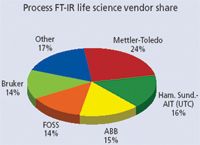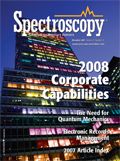Market Profile: Life Science Process FT-IR
Fourier transform–infrared (FT-IR) spectroscopy technology has progressed considerably over the past two decades, and it is now a relatively established analytical technique for process monitoring in addition to being a standard tool in the laboratory. The inherent design of FT-IR systems makes them preferable for use as a process monitoring and analysis tool, particularly in the life science industries, which is a promising market.
Fourier transform–infrared (FT-IR)spectroscopy technology has progressed considerably over the past two decades, and it is now a relatively established analytical technique for process monitoring in addition to being a standard tool in the laboratory. The inherent design of FT-IR systems makes them preferable for use as a process monitoring and analysis tool, particularly in the life science industries, which is a promising market.

Process FT-IR life science vendor share
The core of any FT-IR instrument is the interferometer, which by its very nature provides its own internal calibration. The ability to eliminate the need for external calibration is obviously a major advantage for process instrumentation. In addition, FT- IR provides much higher signal-to-noise ratios in comparison to dispersive IT, which allows for much more rapid analysis.
The process life science market for FT-IR includes pharmaceutical, agriculture & food, and organic chemicals industries. The best known application is probably reaction monitoring, a significant portion of which falls under the definition of process analytical technology (PAT) in the pharmaceutical industry. FT-IR is also useful for identifying the level of key nutritional components in foods. The combined worldwide market for these applications for process FT-IR is estimated to be $20 million, and it is expected to see double-digit growth for some time to come.
The foregoing data were based on SDi's Market Analysis & Perspectives (MAP) report program. For more information, contact Stuart Press, Senior Consultant, Strategic Directions International, Inc., 6242 Westchester Parkway, Suite 100, Los Angeles, CA 90045, (310) 641-4982, fax: (310) 641-8851, www.strategic-directions.com.
AI Shakes Up Spectroscopy as New Tools Reveal the Secret Life of Molecules
April 14th 2025A leading-edge review led by researchers at Oak Ridge National Laboratory and MIT explores how artificial intelligence is revolutionizing the study of molecular vibrations and phonon dynamics. From infrared and Raman spectroscopy to neutron and X-ray scattering, AI is transforming how scientists interpret vibrational spectra and predict material behaviors.
Real-Time Battery Health Tracking Using Fiber-Optic Sensors
April 9th 2025A new study by researchers from Palo Alto Research Center (PARC, a Xerox Company) and LG Chem Power presents a novel method for real-time battery monitoring using embedded fiber-optic sensors. This approach enhances state-of-charge (SOC) and state-of-health (SOH) estimations, potentially improving the efficiency and lifespan of lithium-ion batteries in electric vehicles (xEVs).
New Study Provides Insights into Chiral Smectic Phases
March 31st 2025Researchers from the Institute of Nuclear Physics Polish Academy of Sciences have unveiled new insights into the molecular arrangement of the 7HH6 compound’s smectic phases using X-ray diffraction (XRD) and infrared (IR) spectroscopy.
